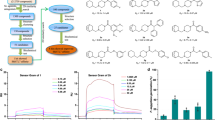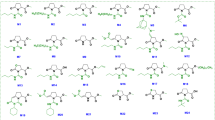Abstract
Striga spp. (witchweed) is an obligate parasitic plant that attaches to host roots to deplete them of nutrients. In Sub-Saharan Africa, the most destructive Striga species, Striga hermonthica, parasitizes major food crops affecting two-thirds of the arable land and over 100 million people. One potential weakness in the Striga infection process is the way it senses the presence of a host crop. Striga only germinates in the presence of the plant hormone strigolactone, which exudes from a host root. Hence small molecules that perturb strigolactone signaling may be useful tools for disrupting the Striga lifecycle. Here we developed a chemical screen to suppress strigolactone signaling in the model plant Arabidopsis. One compound, soporidine, specifically inhibited a S. hermonthica strigolactone receptor and inhibited the parasite's germination. This indicates that strigolactone-based screens using Arabidopsis are useful in identifying lead compounds to combat Striga infestations.
This is a preview of subscription content, access via your institution
Access options
Subscribe to this journal
Receive 12 print issues and online access
$259.00 per year
only $21.58 per issue
Buy this article
- Purchase on Springer Link
- Instant access to full article PDF
Prices may be subject to local taxes which are calculated during checkout





Similar content being viewed by others
References
Gomez-Roldan, V. et al. Strigolactone inhibition of shoot branching. Nature 455, 189–194 (2008).
Umehara, M. et al. Inhibition of shoot branching by new terpenoid plant hormones. Nature 455, 195–200 (2008).
Toh, S. et al. Thermoinhibition uncovers a role for strigolactones in Arabidopsis seed germination. Plant Cell Physiol. 53, 107–117 (2012).
Tsuchiya, Y. et al. A small-molecule screen identifies new functions for the plant hormone strigolactone. Nat. Chem. Biol. 6, 741–749 (2010).
Akiyama, K., Matsuzaki, K. & Hayashi, H. Plant sesquiterpenes induce hyphal branching in arbuscular mycorrhizal fungi. Nature 435, 824–827 (2005).
Parker, C. Observations on the current status of Orobanche and Striga problems worldwide. Pest Manag. Sci. 65, 453–459 (2009).
Johnson, A.W., Rosebery, G. & Parker, C. A novel approach to Striga and Orobanche control using synthetic germination stimulants. Weed Res. 16, 223–227 (1976).
Zwanenburg, B., Nayak, S.K., Charnikhova, T.V. & Bouwmeester, H.J. New strigolactone mimics: structure-activity relationship and mode of action as germinating stimulants for parasitic weeds. Bioorg. Med. Chem. Lett. 23, 5182–5186 (2013).
Toh, S., Holbrook-Smith, D., Stokes, M.E., Tsuchiya, Y. & McCourt, P. Detection of parasitic plant suicide germination compounds using a high-throughput Arabidopsis HTL/KAI2 strigolactone perception system. Chem. Biol. 21, 988–998 (2014).
Zwanenburg, B., Mwakaboko, A.S. & Kannan, C. Perspective of suicidal germination for parasitic weeds control. Pest Manag. Sci. http://dx.doi.org/10.1002/ps.4222 (2016).
Samejima, H., Babiker, A.G., Takikawa, H., Sasaki, M. & Sugimoto, Y. Practicality of the suicidal germination approach for controlling Striga hermonthica. Pest Manag. Sci. 10.1002/ps.4215 (2016).
Cook, C.E., Whichard, L.P., Turner, B., Wall, M.E. & Egley, G.H. Germination of witchweed (Striga lutea Lour.): isolation and properties of a potent stimulant. Science 154, 1189–1190 (1966).
Umehara, M. et al. Structural requirements of strigolactones for shoot branching inhibition in rice and Arabidopsis. Plant Cell Physiol. 56, 1059–1072 (2015).
Zhao, L.H. et al. Destabilization of strigolactone receptor DWARF14 by binding of ligand and E3-ligase signaling effector DWARF3. Cell Res. 25, 1219–1236 (2015).
Waters, M.T. et al. Specialisation within the DWARF14 protein family confers distinct responses to karrikins and strigolactones in Arabidopsis. Development 139, 1285–1295 (2012).
Scaffidi, A. et al. Strigolactone hormones and their stereoisomers signal through two related receptor proteins to induce different physiological responses in Arabidopsis. Plant Physiol. 165, 1221–1232 (2014).
Nelson, D.C. et al. F-box protein MAX2 has dual roles in karrikin and strigolactone signaling in Arabidopsis thaliana. Proc. Natl. Acad. Sci. USA 108, 8897–8902 (2011).
Wallace, I.M. et al. Compound prioritization methods increase rates of chemical probe discovery in model organisms. Chem. Biol. 18, 1273–1283 (2011).
Lomenick, B., Jung, G., Wohlschlegel, J.A. & Huang, J. Target identification using drug affinity responsive target stability (DARTS). Curr. Protoc. Chem. Biol. 3, 163–180 (2011).
Tsuchiya, Y. et al. Probing strigolactone receptors in Striga hermonthica with fluorescence. Science 349, 864–868 (2015).
Ueguchi-Tanaka, M. et al. GIBBERELLIN INSENSITIVE DWARF1 encodes a soluble receptor for gibberellin. Nature 437, 693–698 (2005).
Toh, S. et al. Structure-function analysis identifies highly sensitive strigolactone receptors in Striga. Science 350, 203–207 (2015).
Koornneef, M. & van der Veen, J.H. Induction and analysis of gibberellin sensitive mutants in Arabidopsis thaliana (L.) heynh. Theor. Appl. Genet. 58, 257–263 (1980).
Teka, H.B. Advance research on Striga control: a review. Afr. J. Plant Sci. 8, 492–506 (2014).
Huang, K., Whitlock, R., Press, M.C. & Scholes, J.D. Variation for host range within and among populations of the parasitic plant Striga hermonthica. Heredity 108, 96–104 (2012).
Conn, C.E. et al. PLANT EVOLUTION. Convergent evolution of strigolactone perception enabled host detection in parasitic plants. Science 349, 540–543 (2015).
Berner, D., Ikie, F.O. & Green, J.M. ALS-inhibiting herbicide seed treatments control Striga hermonthica in ALS-modified corn (Zea mays). Weed Technol. 11, 704–707 (1997).
Acknowledgements
The authors wish to acknowledge support from National Science & Engineering Research Council of Canada (NSERC 300001) to P.M. D.H.-S. was partially supported on an NSERC Postgraduate Scholarship–Doctoral (PGS D).
Author information
Authors and Affiliations
Contributions
D.H.-S. designed the study with P.M., and D.H.-S. conducted the chemical screen, yeast two-hybrid, DARTS, YLG hydrolysis and intrinsic fluorescence assays. D.H.-S. also performed the statistical analysis. S.T. and D.H.-S. performed the hypocotyl-based retest experiments and rice growth experiments. D.H.-S. and P.M. wrote the first draft of the manuscript, and Y.T. and S.T. contributed to subsequent revisions of the manuscript.
Corresponding author
Ethics declarations
Competing interests
The authors declare no competing financial interests.
Supplementary information
Supplementary Text and Figures
Supplementary Results, Supplementary Table 1 and Supplementary Figures 1–8. (PDF 3775 kb)
Rights and permissions
About this article
Cite this article
Holbrook-Smith, D., Toh, S., Tsuchiya, Y. et al. Small-molecule antagonists of germination of the parasitic plant Striga hermonthica. Nat Chem Biol 12, 724–729 (2016). https://doi.org/10.1038/nchembio.2129
Received:
Accepted:
Published:
Issue Date:
DOI: https://doi.org/10.1038/nchembio.2129
This article is cited by
-
Strigolactones: diversity, perception, and hydrolysis
Phytochemistry Reviews (2023)
-
Probing strigolactone perception mechanisms with rationally designed small-molecule agonists stimulating germination of root parasitic weeds
Nature Communications (2022)
-
Strigolactones: Current research progress in the response of plants to abiotic stress
Biologia (2022)
-
DiSCount: computer vision for automated quantification of Striga seed germination
Plant Methods (2020)
-
Molecular basis of strigolactone perception in root-parasitic plants: aiming to control its germination with strigolactone agonists/antagonists
Cellular and Molecular Life Sciences (2020)



